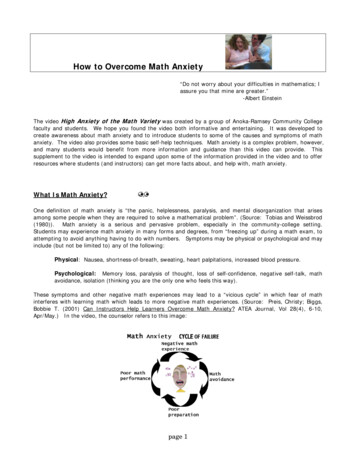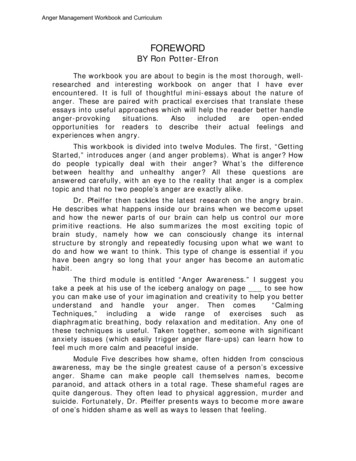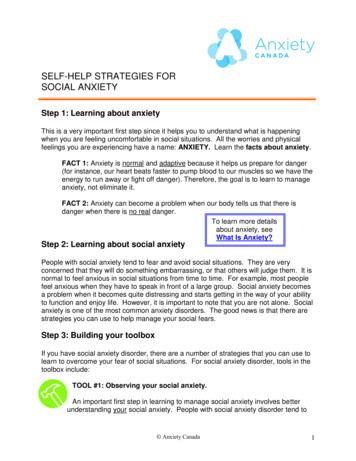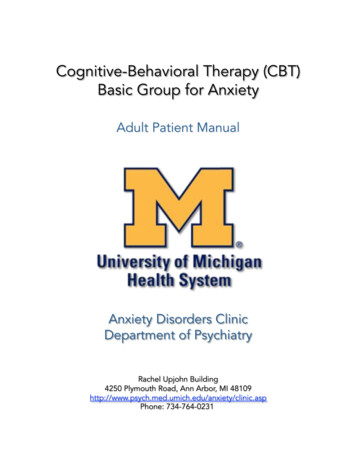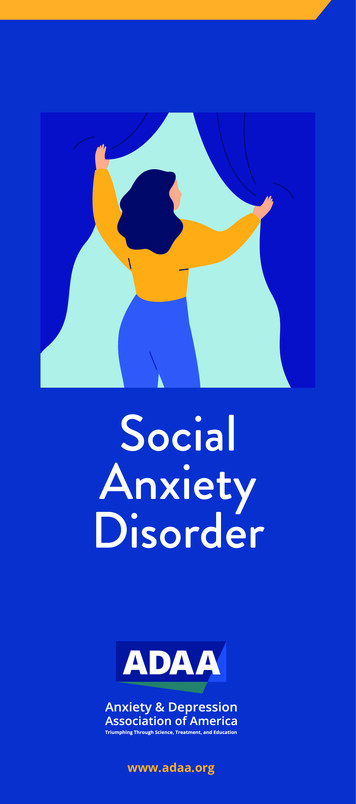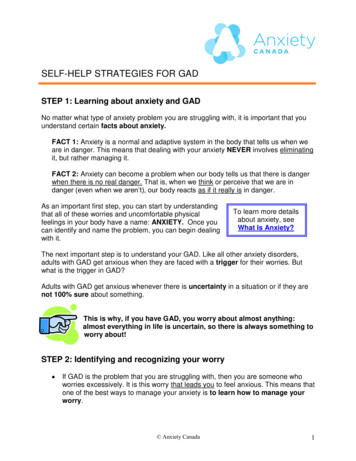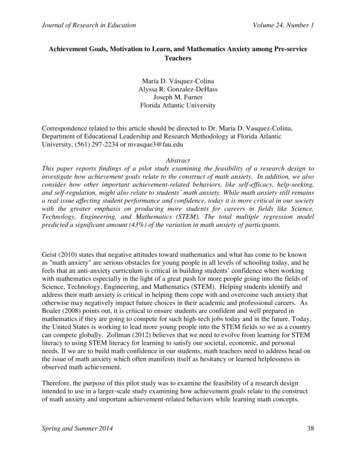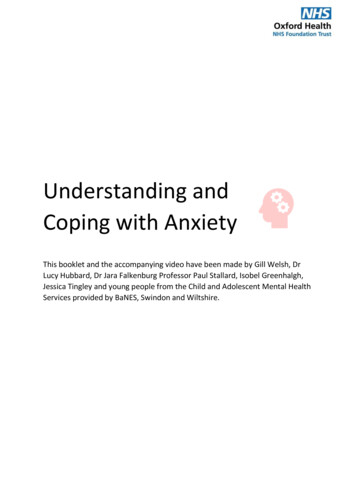
Transcription
International Journal of Academic Research in Business and Social SciencesVol. 1 1 , No. 3, 2021, E-ISSN: 2 2 2 2 -6990 2021 HRMARSMathematics Anxiety: A Case Study of Students’ LearningExperiences through Cognitive, Environment and BehaviourNur Hafizah Musa, Siti Mistima MaatTo Link this Article: 0.6007/IJARBSS/v11-i3/8992Received: 21 January 2021, Revised: 23 February 2021, Accepted: 04 March 2021Published Online: 17 March 2021In-Text Citation: (Musa & Maat, 2021)To Cite this Article: Musa, N. H., & Maat, S. M. (2021). Mathematics Anxiety: A Case Study of Students’Learning Experiences through Cognitive, Environment and Behaviour. International Journal of AcademicResearch in Business and Social Sciences, 11(3), 932-956.Copyright: 2021 The Author(s)Published by Human Resource Management Academic Research Society (www.hrmars.com)This article is published under the Creative Commons Attribution (CC BY 4.0) license. Anyone may reproduce, distribute,translate and create derivative works of this article (for both commercial and non-commercial purposes), subject to fullattribution to the original publication and authors. The full terms of this license may be seenat: deVol. 11, No. 3, 2021, Pg. 932- SJOURNAL HOMEPAGEFull Terms & Conditions of access and use can be found tion-ethics932
International Journal of Academic Research in Business and Social SciencesVol. 1 1 , No. 3, 2021, E-ISSN: 2 2 2 2 -6990 2021 HRMARSMathematics Anxiety: A Case Study of Students’Learning Experiences through Cognitive,Environment and BehaviourNur Hafizah Musa, Siti Mistima MaatFaculty of Education, Universiti Kebangsaan MalaysiaEmail: p96063@siswa.ukm.edu.my, sitimistima@ukm.edu.myAbstractPrior research indicated that mathematics anxiety (MA) is considered as significanteducational problems since it affected students’ emotion, thought and action. Thus, thisarticle aims to explore the issue of MA among secondary school students as viewed throughstudents’ learning experiences focusing on three main aspects – cognitive, environment andbehaviour. The study also reports on students’ mathematics learning anxiety andmathematics assessment anxiety particularly within educational context. A qualitativeresearch approach using case study design was structured in this study. Participants involved7 highly math-anxious students (aged 16) from a secondary school in Malaysia. The data wascollected through semi-structured interview, transcribed and analyzed to establish themesand subthemes. Findings revealed that for anxiety in mathematics learning, stress or pressureand mentality were students main concern for MA whereas for anxiety in mathematicsassessment, self-confidence and anxiousness were indicated. As for students’ learningexperience five subthemes were developed from the findings – (1) self-conflict for cognitiveaspect, (2) external influence and (3) content or nature of mathematical knowledge forenvironmental aspect, (4) the importance of mathematics and (5) strategies in mathematicslearning for behavioural aspect. This study also found that MA was experienced by both mathhigh- and low-achieving students. However, for high-achieving students, motivational factorwas their main influence towards MA whereas for low-achieving students, poor mathcompetency and self-skills were the major contributors. The article offers in-depthunderstanding for educators particularly in terms of diagnostic study for MA throughstudent’s perspective and they can use this information to identify ways of reducing MA.Keywords: Mathematics Anxiety (MA), Learning Anxiety, Assessment Anxiety, Cognitive,Environment, Behaviour.IntroductionMathematics is one of the branches of knowledge that studies the quantity, structure, spaceand problem solving that requires skills in calculations and critical thinking (Kusmaryono,Gufron, & Rusdiantoro, 2020). In general, mathematics plays an important role in every aspectof life, but the main contribution of mathematics is in the field of education. Through theperspective of education globally, mathematics is perceived as one of the most difficult933
International Journal of Academic Research in Business and Social SciencesVol. 1 1 , No. 3, 2021, E-ISSN: 2 2 2 2 -6990 2021 HRMARSsubjects to learn due to its complexity and abstract nature (Azizah & Suhendra, 2020; Haase,Guimarães, & Wood, 2019). Furthermore, the learning process that is interconnected andrequires mastery comprehension from the previous topics causes students to strugglethroughout mathematics lesson.In the context of education, common issues underpinning mathematics learningdifficulties are students’ lack of conceptual understanding and poor mathematics skills(Salehudin, Hassan, & Hamid, 2015.). As a result, students tend to be scared, worried and feelless interested to learn mathematics in depth (Nachiappan, 2016; Yahya & Amir, 2018).However, since mathematics is one of the key elements of success in disciplines ranging fromscience, technology to economics, excellent qualifications are necessary for students topursue mathematics at higher level. Therefore, the existing curriculum needs to be reviewedand evaluated constantly to improve the quality of education and produce a world-classmathematics education system.One of the main challenges for the Ministry of Education Malaysia (MOE) toimplement the education transformation plan within the area of mathematics is thedeteriorating performance of Malaysian students in mathematics. This concern is based onthe report from Trends in International Mathematics and Science Study (TIMSS) in 1999, 2003,2007, 2011, and 2015 as well as Programme for International Student Assessment (PISA) in2009, 2012, 2015, and 2018 which shows that Malaysian students’ performance inmathematics domain were below average as compared to global average score (Abdullah,Chong, & Wong, 2017; MOE, 2016; OECD, 2019). The empirical evidence indicates thatMalaysian students' level of mathematics competency is lower and far behind the highincome countries especially within Asia. Besides, there is also a report on the decliningnumber of students who choose Science/Technical and Science, Technology, Engineering, andMathematics (STEM) streams due to students’ perception of sciences subject difficultiesinvolving Additional Mathematics, Physics, and Chemistry. Thus, these negative perceptionsaffect students’ interest in mathematics and eventually leads to the emergence of MA.Other than that, MA is also believed to be indirectly associated with students’emotions, feelings and thoughts. Haase et al. (2019) describe the relation betweenmathematics and emotions as complex and interconnected where activities involvingmathematics can initiate either positive or negative reactions. However, previous studiesregarding this issue focused more on the negative side which is related to MA (Deieso &Fraser, 2019; Gunderson, Park, Maloney, Beilock, & Levine, 2018; Hill, Mammarella, Devine,Caviola, Passolunghi, & Szűcs, 2016; Recber, Isiksal, & Koç, 2018; Rozgonjuk, Kraav, Mikkor,Orav-Puurand, & Täht, 2020). According to Ashcraft (2002), MA is defined as feeling oftension, apprehension, or fear that interferes with mathematics performance or tasks.Individuals who confronted negative thoughts or feelings have a greater tendency to avoidmath-related activities due to their experience in learning (Andrews & Brown, 2015).In addition, MA can also lead to serious psychological and psychosomatic problemswithout proper addressed (Pletzer et al., 2015) since students who experience MA engage intwo things at once; dealing with mathematical tasks complexity and overcoming negativefeelings or thought (Ramirez, Shaw, & Maloney, 2018). As a result, students’ confidence leveland mathematics performance will be affected, subsequently leads to a situation where934
International Journal of Academic Research in Business and Social SciencesVol. 1 1 , No. 3, 2021, E-ISSN: 2 2 2 2 -6990 2021 HRMARSstudents are no longer interested in learning mathematics (Arslan, 2020). Therefore, MAshould be taken seriously as previous evidence suggests that MA has a negative impact onstudents’ achievement at all levels (Ersozlu & Karakus, 2019), affect students’ abilities(Jatisunda et al., 2020) and contributes to students’ failure in mathematics (Fong et al., 2017).Research on MA has a long tradition and since the 1950s, numerous studies have beenconducted at the international level. Based on the bibliometric analysis by Ersozlu andKarakus (2019), in the past decades, many researches investigate the factors associated withMA at individual context such as motivation, self-efficacy, self-concept, gender differencesand test anxiety. Moreover, the meta-analysis by Namkung, Peng and Lin (2019) involving 131studies also identified cognitive and environment as the main factors leading to MA. Changand Beilock (2016) classified these factors into two areas namely individual (cognitive,affective/physiological, motivational) and environmental (social/contextual). This finding issupported by Yahya and Amir (2018) and Garba, Ismail, Osman and Rameli (2020) who foundthree aspects that affected MA; cognitive, social and individual. Past researches on cognitiveaspects mostly focused on self-efficacy and cognitive resource which is working memory(WM) (Beilock & Maloney, 2015; Ersozlu & Karakus, 2019; Ramirez et al., 2018). Next, socialaspects explore on environmental factors such as parents’ mathematical attitudes andconcerns (Batchelor, Gilmore, & Inglis, 2017; Chang & Beilock, 2016; Maloney, Ramirez,Gunderson, Levine, & Beilock, 2015), peer influence (Garba et al., 2020) and teachingmethods (Mann & Walshaw, 2019; Sofiatun, Sampoerna, & El Hakim, 2018). Finally, individualaspects are seen through the student’s behaviour such as attitude towards mathematics(Recber et al., 2018) and motivation in learning mathematics (Wang, Lukowski, Hart, Lyons,Thompson, Kovas, & Petrill, 2015). Findings from these past literatures on MA suggested thatit is directly related to cognitive, environment and behaviour. Thus, more comprehensivestudies may provide valuable insights into these issues.Furthermore, although many researchers have examined the issues of MA, most ofthe studies conducted using quantitative approach (Garba et al., 2019; Namkung et al., 2019)and focused on common factors such as gender, age – level of education, mathematicsachievement and performance (Gunderson et al., 2018; Hill et al., 2016). Apart from that, toour knowledge, little attention on MA using qualitative approach has been explored atnational level. Most of the quantitative research studies MA related to students’ mathematicsachievement at school level (Hunt & Zakaria, 2018; Puteh & Khalin, 2016; Yahya & Amir, 2018)or tertiary education (Desa, Saad, Zakaria, & Zakaria, 2016; Yazid, Azziz, Zakaria, & Desa, 2016;Zakaria, Azziz, Yazid, & Saad, 2016). Therefore, there is a need for a more in-depth study togain better understanding of MA through student’s perspective and discover this issue basedon students learning experience.The purpose of this study is to explore the issue of MA among secondary schoolstudents who follow the learning system based on Malaysian National Secondary SchoolStandard Curriculum (KSSM). Accordingly, this study focuses on the issue of MA as viewedthrough students’ experiences towards mathematics in the form of cognitive, environmentand behaviour.In summary, the present study is design to answer the following questions:935
International Journal of Academic Research in Business and Social SciencesVol. 1 1 , No. 3, 2021, E-ISSN: 2 2 2 2 -6990 2021 HRMARS In what way do students experience MA?What are the aspects of mathematics learning experience in the form of cognitive,environment and behaviour that contributes to students’ MA?For the next section, literature review related to MA will be further explained, followedby the research methodology process. Then, the findings obtained from this study will bepresented and discussed in details. Finally, this paper concludes with implications, limitationsand suggestions for further study.Literature ReviewMathematics Anxiety (MA)Anxiety refers to an emotional disorder that causes nervousness, fear, worry, panic orapprehension (Jatt, 2019). This situation will indirectly affect how humans act and think. MAoccurs when an individual experiences emotional disorders or negative emotion due tosituations involving mathematics in learning or daily activities (Namkung et al., 2019).According to Chang and Beilock (2016), math-anxious individuals tend to show psychologicalsymptoms such as tension, negative thinking and avoiding themselves from anymathematical circumstances (Andrews & Brown, 2015) or physiological symptoms such assweating, nervous, pale or having high blood pressure (Namkung et al., 2019). Therefore, formath-anxious individuals, solving math-related problems or involving in math-activities areseen as burdens because of an emotional gap (Haase et al., 2019) and there is a tendencyfor the thought of effects and consequences (Beilock & Maloney, 2015).Among the main focus of investigation on MA from the prior studies is the effect ofMA on students’ performances or achievement in mathematics. Findings from Foley, Herts,Borgonovi, Guerriero, Levine and Beilock (2017), Mutlu (2019), Namkung et al. (2019) andRamirez et al. (2018) proved that there is a negative correlation between MA and students’performances – a high level of MA leads to poor mathematics achievement. According toRamirez et al. (2018), this situatioan happened because MA affects students’ mathematicalabilities or skills. As a result, the student’s learning process is disrupted, students feel lessmotivated (Suren & Kandemir, 2020), depressed (McDonough & Ramirez, 2018; Murphy,2018), less confident (Namkung et al., 2019), reduce student’s interest in mathematics andconsequently leads to math-avoidance behaviour (Mutlu, 2019). On the other hand,students with high level of self-efficacy (Kahramanoğlu & Deniz, 2017) will have a positiveattitude, tend to be more proficient in mathematics and subsequently enhance theirmathematics performance. Situations involving MA, if not properly addressed will lead tothe risk of reducing the possibility of students to venture into the field of mathematics at ahigher level. This evidence is stated by Dowker, Sarkar and Looi (2016) in which MA affectsstudents' decision involving future studies or the choice of career path. Therefore,identifying the problem of MA especially during the earlier stage of active learning is veryimportant to avoid negative impact in the future and at the same time overcoming MAthrough the process of recovery and early intervention (Namkung et al., 2019).Apart from learning, MA is also influenced by assessment. According to Mann andWalshaw (2019), anxiety in assessment is the biggest factor contributing to MA. This isbecause math-anxious students become very nervous under evaluation and they tend to havea negative perception or expectation towards assessment. This situation coincides with936
International Journal of Academic Research in Business and Social SciencesVol. 1 1 , No. 3, 2021, E-ISSN: 2 2 2 2 -6990 2021 HRMARSPutwain et al. (2015) who defined test anxiety as an individual’s tendency to evaluate testingas a form of threat. Andrews and Brown (2015) study of 180 students at the university levelalso found that student’s MA level is higher during assessment than learning. The samefindings were also obtained by Arslan (2020) through a study of 337 students, indicating apositive correlation between MA and test anxiety. In fact, according to Arslan (2020), one ofthe situations that leads to the high level of MA is anxiety during assessment. This is due tothe environmental factors such as intense competition and high stress level in community(Koçoğlu & Kaya, 2016). However, Dowker et al. (2016) argued that although relationshipbetween MA and test anxiety existed, the relationship between other constructs in MA arestronger especially in terms of poor mathematical skills and low mastery level.Mathematics Learning ExperienceAccording to Gagné (1985), learning is a process of behavioural changes (outcomes) as aresult of the knowledge transmission and skills acquired throughout the process. Experienceduring the learning process can positively or negatively affect an individual’s behaviourdepending on the situation involved. Based on Bandura's Social Cognitive Theory (1977,1986, 1997, 2001), there are three main principles that influence the learning process,namely cognitive, environment and behaviour. All of these elements are interconnectedthrough bidirectional relation. Therefore, according to previous studies, the student’smathematics learning experience is examined through these three aspects; (1) cognitive, (2)environment (social) and (3) behaviour (individual) (Chang & Beilock, 2016; Garba et al.,2020; Namkung et al. 2019; Suren & Kandemir, 2020; Yahya & Amir, 2018). Experiencemeans any occurrence or everything that the students encountered and still rememberedthroughout the mathematics learning process.CognitiveCognitive aspect in MA interferes learning abilities that involve individual’s perceptions,thoughts or interpretations for future possibilities (Beilock & Maloney, 2015). This opinion issupported by Haase et al. (2019) who stated that MA disrupts the human’s cognitive systemand causes the emergence of perceptions through attitudes toward mathematics, math selfconcept and math self-efficacy. This is because low levels of self-efficacy and mathematicalskills results in lack of self-confidence, inhibit critical and creative thinking skills andconsequently lead to MA (Batchelor et al., 2017; Pletzer et al., 2015; Ramirez et al., 2018).According to Foley et al. (2017), working memory (WM) is an element in the cognitive systemthat serves as a place to store short-term information and where the process of informationmanipulation occurs. For math-anxious individuals, the disruption in WM processing triggerslimited WM capacity, reduces response levels and information processing which ultimatelyaffects mathematical ability and leads to poor math performance (Namkung et al., 2019). Asa result, that person will easily become panic, feel unpleasant and eventually avoid any mathrelated activities (Haase et al., 2019; Ersozlu & Karakus, 2019).In addition, based on previous studies, cognitive aspect is also related to self-efficacy.Self-efficacy is defined as belief in one's ability to successfully complete or perform aparticular task. Findings suggested that self-efficacy negatively associated with MA (Andrews& Brown, 2015; Kahramanoğlu & Deniz, 2017; Rozgonjuk et al., 2020) because students whoare less confident in their own math abilities tend to feel nervous or afraid especially in thesituations involving tests or evaluations. Self-conflict can also emerges due to the feelings of937
International Journal of Academic Research in Business and Social SciencesVol. 1 1 , No. 3, 2021, E-ISSN: 2 2 2 2 -6990 2021 HRMARSdoubt and disbelief in one's own math skills which in turn can affect the learning process. Asa result, students who are suffering from this situation will have low levels of self-motivation(Gunderson et al., 2018; Pletzer et al., 2015). This is due to self-efficacy as a major factor thatmotivates students and determine how much effort or perseverance that they are willing toput in completing math tasks.EnvironmentNext, the environmental aspects mainly associated with influence from external parties suchas family members, teachers and friends as well as the content and nature of mathematicsknowledge itself. Parents who constantly monitor their children's learning development(Maloney et al., 2015), provide encouragement and motivation (Wang et al., 2015) arebelieved to help in reducing MA. Even so, Batchelor et al. (2017) found that the negativeinfluence on children's MA stems from the parents’ attitudes who have high expectationsdue to the society and excessive control over their children’s academic achievement.However, this situation vary differently for each family according to their background,nurture, characteristic and parents’ level of MA (Haase et al., 2019).As for peer influence, Ditrick (2018) in his study stated that students tend to seekhelp from their classmates or peers apart from the teacher because they feel morecomfortable and less pressure to ask a friend for help in math. In addition, students alsoutilise guidance and support from peers to improve their performance (Moliner & Alegre,2020). This positive effect occurs due to the active and cooperative learning strategiesapplied in class which enhance student’s self-confidence, self-concept and attitude towardsmathematics. However, the study of Garba et al. (2019) on highly math-anxious studentsproved that the main effects of peer influence on MA are through negative aspects such as(1) attitude (overly dominate the class) and (2) conversation (negative words orprovocation).In addition, teachers’ attitude and teaching strategies play an important role toinfluence students’ actions and thoughts in math-related activities. This is because effectiveteaching methods with the use of various strategies will spark students’ interests andreinforce their understanding in mathematics concepts (Mann & Walshaw, 2019). At thesame time, teachers also provide supports in terms of emotional (encouragement,confidence, empathy) and instrumental (practical guidance for complex tasks) (Mann &Walshaw, 2019). However, Cumhur and Tezer (2019) reported opposite findings such thatno significant difference existed between student’ MA level and teachers’ attitude forstudents at school level. This is because other factors such as emotional and motivation aremore dominant in predicting MA. Lastly, Aydin & Keskin (2017) believed that abstract andcomplex mathematical concepts as well as students' failure to relate math concepts intoreal-life situations are the main reasons for MA.BehaviourBehavioural aspects refer to attitudes and strategies in learning mathematics. According toRecber et al. (2018), positive attitudes help to increase students' self-efficacy and in turnreduce the level of MA. Findings from the study of Recber et al. (2018) over 934 schoolstudents, showed that attitude is one of the significant construct to determine mathachievement because students who have positive math-attitude are always prepared and938
International Journal of Academic Research in Business and Social SciencesVol. 1 1 , No. 3, 2021, E-ISSN: 2 2 2 2 -6990 2021 HRMARSexcited toward the learning activities (Suren & Kandemir, 2020). This situation will indirectlybuild self-confidence and help students to succeed in mathematics. On the other hand, highmath-anxious individuals tend to show negative attitudes because they assume thatmathematics is insignificant, have low self-efficacy and have no desire to succeed inmathematics for the future (Maloney et al., 2015). However, anxiety at a moderate level isalso necessary especially for highly motivated students to encourage them becoming moreeager and diligent in solving challenging math problems. Concurrently, students will alwayshave positive thought and regard math learning as a fun activity (Wang et al., 2015).Other than that, for some individuals, MA occurs due to the failure of understandingmath concepts and insufficient math skills which in turn reducing the level of motivation. Ifstudents are overly attached to less flexible problem-solving methods and simpleapproaches, cognitive systems involving working memory will be disrupted (Morsanyi,Cheallaigh, & Ackerman, 2019). Thus, students' ability to process information will beaffected, particularly for math-anxious students (Namkung et al., 2019). This situation is alsomore severe in math problems involving abstract and high-order thinking skills (HOTS).MethodologyResearch DesignThis qualitative study was structured by using case study design to gain an in-depthunderstanding of MA according to participants’ own experiences. A case study is a holisticexploration of a specific phenomenon arising from particular individuals or groups to obtaina rich explanation (Ghazali & Sufean, 2018). Therefore, in this research, the case studymethod was chosen to examine and obtained a detailed interpretation of MA phenomenonfor students who follow KSSM syllabus.Participants and ProceduresThis research consisted of two phases. Phase 1 involved survey and analysis of students’mathematics exam results. Particularly, to identify suitable participants who would fit to bein Phase 2 for the semi-structured interview. This study was conducted in a secondary schoolin Negeri Sembilan involving 142 Form Four students (age 16 years old) who follow KSSMsyllabus. For Phase 1, all participants completed the MA questionnaire. Then, students’performance in mathematics were analyzed through results from Final Semester Examinationand Form Three Assessment (PT3). Based on the findings from Phase 1, a total of sevenparticipants were selected to proceed for Phase 2. These participants were chosen by usingpurposive sampling method to ensure that they fit the study criteria set by the researcher –participant with high level of MA as well as math high- and low-achieving students. Theprofiles of the selected participants for Phase 2 are as follows:939
International Journal of Academic Research in Business and Social SciencesVol. 1 1 , No. 3, 2021, E-ISSN: 2 2 2 2 -6990 2021 HRMARSTable 3.1: Profile of ParticipantsCategory GenderAverage grade Mathematicsin Mathematics hAverage score inMAquestionnaire3.964.163.684.324.084.043.84MA levelHighHighHighHighHighHighHighFrom Table 3.1, in the category section, PR is referring to the math low-achieving participantswhile PT represent math high-achieving students. Participants are labeled as in Table 1without using their real names to guarantee and adhere to confidentiality ethics whilereporting the findings of the research.InstrumentsQuestionnaireThe questionnaire adopted from Salwani and Salleh (2001) was used in this study to measurestudents’ MA. Salwani and Salleh (2001) revised a combination of several instrumentsestablished from past studies namely Mathematics Anxiety Rating Scale (MARS) byRichardson & Suinn (1972), Revised Mathematics Anxiety Rating Scale (RMARS) by Plake &Parker (1982), The Phobus Mathematics Anxiety Inventory by Ferguson (1986) and KazelskisAnxiety Inventory by Kazelskis (1998). The questionnaire consisted of two sections;demographic (6 items) for Section A and mathematics anxiety, MA (25 items) for Section B.Each item in Section B was measured using a five-point Likert scale (1 not at all, 5 verymuch). The total score of MA in this questionnaire is 125 which is calculated from the totalmaximum value of the Likert scale (five for each item). Then, the level of MA of theparticipants were determined through the average value of the total score as referred fromSalwani and Salleh (2001).InterviewNext, for Phase 2 of this study, the semi-structured interview protocol was adapted fromCroley (2003), Ditrick (2018), Mann (2017) and Murphy (2018). This instrument consisted of8 open-ended questions and several sub-questions for each. However, since semi-structuredinterviews were conducted, the questions asked during the interview sessions were flexibleand allowed the researcher to spontaneously explore other relevant areas based on theparticipants’ responses. The interviews were approximately between 45 to 90 minutes andrecorded with the participants’ consents.Validity and ReliabilityInstrumentsThe MA questionnaire and interview protocol were reviewed by three experts in theirrespective fields for face and content validity, namely two educators with more than 15 yearsof experience in language and mathematics as well as a counselor who has served for morethan 10 years in the area related to psychology. Then, a pilot study was conducted among 21940
International Journal of Academic Research in Business and Social SciencesVol. 1 1 , No. 3, 2021, E-ISSN: 2 2 2 2 -6990 2021 HRMARSForm Four students in another secondary school at Negeri Sembilan to examine the reliabilityof the instrument. The result of statistical analysis showed value of Cronbach’s Alphacoefficient of 0.801. Hence, the reliability of this instrument was acceptable as suggested byHair, Black, Babin, & Anderson (2013).Research trustworthinessIn a qualitative study, the validity and reliability are two substantial criteria to ensure theaccuracy and consistency of the data collected (Cohen, Manion, & Morrison, 2017).Therefore, in order to obtain true results supported by solid evidence, triangulation methodsinvolving document analysis and interviews were conducted by researcher in this study.According to Cohen et al. (2017), triangulation refers to a research technique that uses twoor more data collection methods to obtain better understanding and in-depth perspective ofthe study. Creswell and Poth (2018) also stated that triangulation involves the process ofestablishing evidences supported by multiple data sources or approaches to ensure therigorousness of research.AnalysisFor Phase 1, the data collected were analyzed using Statistical Package for Social Science(SPSS) version 23.0. Descriptive analysis was utilised to determine the total score, the averagevalue of the total score and identify the participants’ MA levels. In addition, participants’marks for mathematics in Final Semester Examination and PT3 were analyzed to obtain theaverage to
Mar 17, 2021 · behaviour. The study also reports on students’ mathematics learning anxiety and mathematics assessment anxiety particularly within educational context. A qualitative research approach using case study design was structured in this study. Participants involved 7 highly math-anxiou


